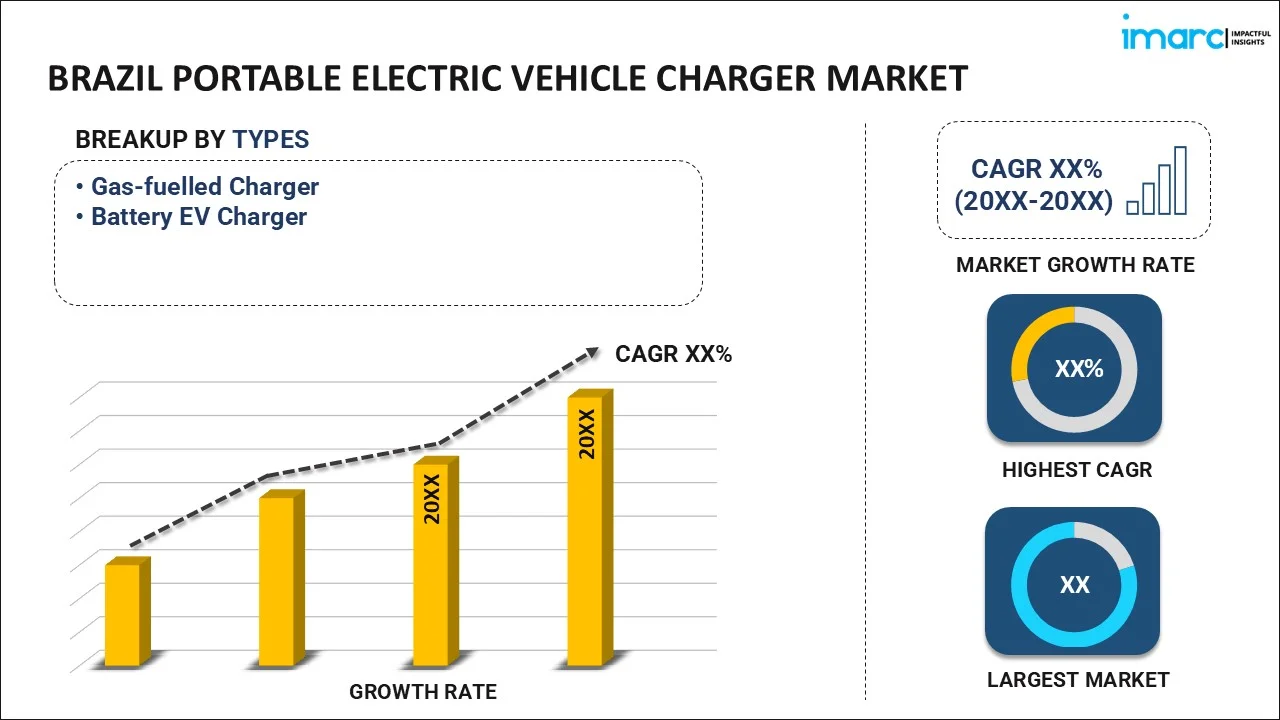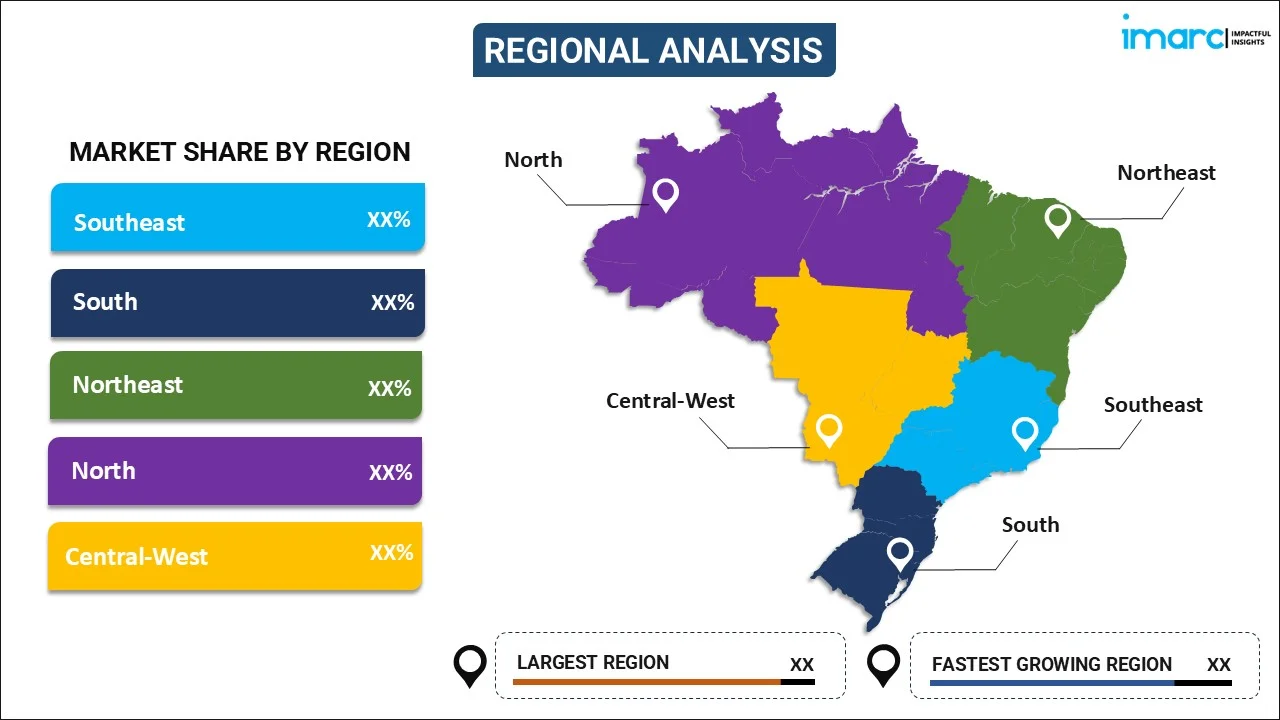
Brazil Portable Electric Vehicle Charger Market Size, Share, Trends, and Forecast by Type, Current Type, End-User, Application, and Region, 2026-2034
Brazil Portable Electric Vehicle Charger Market Overview:
The Brazil portable electric vehicle charger market size reached USD 1,106.6 Million in 2025. Looking forward, IMARC Group expects the market to reach USD 6,542.7 Million by 2034, exhibiting a growth rate (CAGR) of 21.83% during 2026-2034. The market is driven by the widespread adoption of electric vehicles, expansion of charging infrastructure, the rising consumer demand for portable charging solutions, government incentives for electric mobility, and ongoing advancements in fast-charging technology.
|
Report Attribute
|
Key Statistics
|
|---|---|
|
Base Year
|
2025
|
|
Forecast Years
|
2026-2034
|
|
Historical Years
|
2020-2025
|
| Market Size in 2025 | USD 1,106.6 Million |
| Market Forecast in 2034 | USD 6,542.7 Million |
| Market Growth Rate (2026-2034) | 21.83% |
Brazil Portable Electric Vehicle Charger Market Trends:
Increasing Electric Vehicle Adoption:
One of the major trends propelling the demand for portable electric vehicle chargers is the increasing use of electric vehicles (EVs) in Brazil. As per Global Voices, within Brazil's population of 215 million people, EVs have steadily gained popularity over the past few years. In 2023, there was a 91% increase in EV cars sold compared to the previous year. As consumers turn towards greener modes of transportation, sales of EVs have boomed, and in response, people are looking for easy and reliable charging options. Portable chargers provide flexibility because they enable drivers to charge the car at home, at office, or when out and about, lessening the reliance on public charging. This ease of use is pivotal in a segment where charging infrastructures are evolving. In addition, Brazil's pledge to decrease carbon emissions follows the worldwide movement toward electric mobility, which boosts the demand for EVs and, by extension, portable chargers. As manufacturers introduced more affordable EV models, large number of the population is likely to adopt electric vehicles, further propelling the expansion of the portable charger market. Furthermore, efforts by the Brazilian government to incentivize electric mobility in terms of tax incentives and subsidies also motivate consumers to switch to EVs, hence boosting the demand for portable charging solutions.
Expansion of Charging Infrastructure:
The expansion of charging infrastructure across Brazil is another significant trend influencing the portable electric vehicle charger market. As the EV market grows, the need for a reliable and widespread charging network becomes essential. Brazil is investing in the development of public and private charging stations. For instance, in September 2024, WEG announced a partnership with Mercedes-Benz Cars & Vans Brazil to become the recommended provider of charging infrastructure for customers purchasing 100% electric vehicles. This collaboration aims to enhance customers' experience by providing them a choice for the WEG WEMOB WALL charging station, which offers convenience, safety, and intelligent charging solutions for home installations. In the interim, portable chargers provide an effective solution for EV owners who may not have easy access to a charging station. With more EVs on the road, there is a growing need for flexible and mobile charging options to ensure vehicles are always powered. Portable chargers are filling this gap by offering a convenient alternative, especially in rural or underserved areas where charging stations are scarce. Moreover, the portability of these devices makes them an attractive option for those who frequently travel long distances or need an emergency charging solution. As the infrastructure improves, the demand for portable chargers is expected to remain strong, complementing fixed charging stations and enhancing the overall charging ecosystem in Brazil.
Brazil Portable Electric Vehicle Charger Market Segmentation:
IMARC Group provides an analysis of the key trends in each segment of the market, along with forecasts at the country level for 2026-2034. Our report has categorized the market based on type, current type, end-user and application.
Type Insights:

- Gas-fuelled Charger
- Battery EV Charger
The report has provided a detailed breakup and analysis of the market based on the type. This includes gas-fuelled charger and battery EV charger.
Current Type Insights:
- AC
- DC
A detailed breakup and analysis of the market based on the current type have also been provided in the report. This includes AC and DC.
End-User Insights:
- Electric Vehicles
- Commercial Car
- Passenger Car
- Aviation
- Others
The report has provided a detailed breakup and analysis of the market based on the end-user. This includes electric vehicles (commercial car and passenger car), aviation, and others.
Application Insights:
- Roadside Assistance Companies
- Utilities
- Shared Fleet Operator
- Others
A detailed breakup and analysis of the market based on the application have also been provided in the report. This includes roadside assistance companies, utilities, shared fleet operator, and others.
Regional Insights:

- Southeast
- South
- Northeast
- North
- Central-West
The report has also provided a comprehensive analysis of all the major regional markets, which include Southeast, South, Northeast, North, and Central-West.
Competitive Landscape:
The market research report has also provided a comprehensive analysis of the competitive landscape. Competitive analysis such as market structure, key player positioning, top winning strategies, competitive dashboard, and company evaluation quadrant has been covered in the report. Also, detailed profiles of all major companies have been provided.
Brazil Portable Electric Vehicle Charger Market News:
- In March 2024, ABB and the Graal Group announced partnership to commence the development of an electric vehicle (EV) charging network serving Brazil’s major cities. More than 40 ABB fast and semi-fast chargers are being installed on Graal forecourts and service stations in five of Brazil’s major states: São Paulo, Minas Gerais, Rio de Janeiro, Santa Catarina and Rio Grande do Sul. The ten fast and 31 semi-fast chargers will contribute to Brazil’s transition from a mobility network that is heavily dependent on fossil fuels to one that incorporates an EV charging network.
- In February 2024, notable Brazilian company Raizen and Chinese automaker BYD announced a strategic partnership to deploy a vast network of 600 EV charging stations across the country. This initiative aims to meet the increasing demand for charging infrastructure and accelerate the adoption of electric mobility in Brazil.
Brazil Portable Electric Vehicle Charger Market Report Coverage:
| Report Features | Details |
|---|---|
| Base Year of the Analysis | 2025 |
| Historical Period | 2020-2025 |
| Forecast Period | 2026-2034 |
| Units | Million USD |
| Scope of the Report |
Exploration of Historical Trends and Market Outlook, Industry Catalysts and Challenges, Segment-Wise Historical and Future Market Assessment:
|
| Types Covered | Gas-fuelled Charger, Battery EV Charger |
| Current Types Covered | AC, DC |
| End-Users Covered |
|
| Applications Covered | Roadside Assistance Companies, Utilities, Shared Fleet Operator, Others |
| Regions Covered | Southeast, South, Northeast, North, Central-West |
| Customization Scope | 10% Free Customization |
| Post-Sale Analyst Support | 10-12 Weeks |
| Delivery Format | PDF and Excel through Email (We can also provide the editable version of the report in PPT/Word format on special request) |
Key Questions Answered in This Report:
- How has the Brazil portable electric vehicle charger market performed so far and how will it perform in the coming years?
- What is the breakup of the Brazil portable electric vehicle charger market on the basis of type?
- What is the breakup of the Brazil portable electric vehicle charger market on the basis of current type?
- What is the breakup of the Brazil portable electric vehicle charger market on the basis of end-user?
- What is the breakup of the Brazil portable electric vehicle charger market on the basis of application?
- What is the breakup of the Brazil portable electric vehicle charger market on the basis of region?
- What are the various stages in the value chain of the Brazil portable electric vehicle charger market?
- What are the key driving factors and challenges in the Brazil portable electric vehicle charger market?
- What is the structure of the Brazil portable electric vehicle charger market and who are the key players?
- What is the degree of competition in the Brazil portable electric vehicle charger market?
Key Benefits for Stakeholders:
- IMARC’s industry report offers a comprehensive quantitative analysis of various market segments, historical and current market trends, market forecasts, and dynamics of the Brazil portable electric vehicle charger market from 2020-2034.
- The research report provides the latest information on the market drivers, challenges, and opportunities in the Brazil portable electric vehicle charger market.
- Porter's five forces analysis assist stakeholders in assessing the impact of new entrants, competitive rivalry, supplier power, buyer power, and the threat of substitution. It helps stakeholders to analyze the level of competition within the Brazil portable electric vehicle charger industry and its attractiveness.
- Competitive landscape allows stakeholders to understand their competitive environment and provides an insight into the current positions of key players in the market.
Need more help?
- Speak to our experienced analysts for insights on the current market scenarios.
- Include additional segments and countries to customize the report as per your requirement.
- Gain an unparalleled competitive advantage in your domain by understanding how to utilize the report and positively impacting your operations and revenue.
- For further assistance, please connect with our analysts.
 Request Customization
Request Customization
 Speak to an Analyst
Speak to an Analyst
 Request Brochure
Request Brochure
 Inquire Before Buying
Inquire Before Buying




.webp)




.webp)












